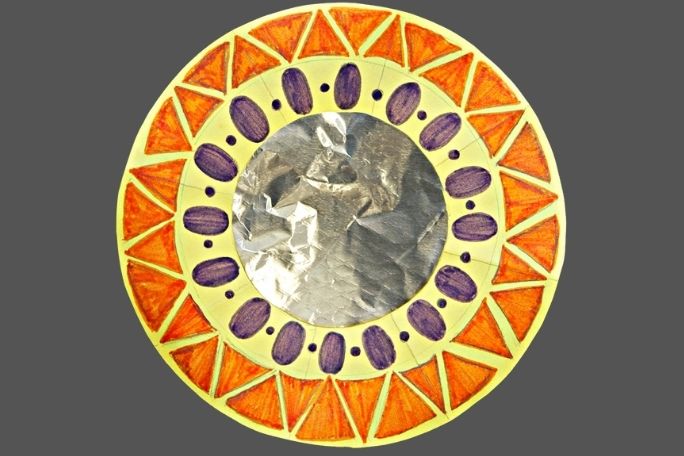Lesson summary
This is a STEAM lesson, which adds the Arts to STEM (Science, Technology, Engineering and Mathematics). To find out more about STEAM and STEM, click here.
In this lesson, students combine skills in Mathematics and Visual Arts to create mirrors inspired by Mexican folk art. They begin by viewing examples of Mexican paintings and observing similarities in the artworks. They subsequently connect their observations with knowledge and understanding of symmetry to create their mirrors. In this way, the lesson engages students in the interconnected nature of art and mathematics.
Learning intentions:
Students will...
- understand rotational (radial) symmetry
- apply artistic techniques from different cultures and times.
Success criteria:
Students can...
- explain what rotational (radial) symmetry is
- create works of art with rotational (radial) symmetry
- share observations about artwork from other cultures
- apply techniques observed in the work of others in their own work.
Lesson guides and printables
Lesson details
Curriculum mapping
We encourage you to teach STEAM both through and between disciplines (transdisciplinary).
This lesson could be used across various strands of the curriculum, including Maths and Visual Arts. Consider focusing on a curriculum strand that will complement other areas of learning you and your students are working on.
Syllabus outcomes: VAS3.1, VAS3.2, VAS3.3, VAS3.4, MA3‑1WM, MA3‑2WM, MA3‑3WM, MA3-15MG, MA3-16MG
General capabilities: Literacy, Numeracy, Intercultural Understanding, Critical and Creative Thinking.
Cross-curriculum priority: Sustainability
Relevant parts of Year 5 and 6 Visual Arts Achievement Standards: Students explain the ways that visual conventions, visual arts processes and materials are used in artworks they create and/or experience. They describe how artworks created across cultures, times, places and/or other contexts communicate ideas, perspectives and/or meaning. They present documentation and artworks that communicate ideas, perspectives or meaning in informal and/or formal settings.
Relevant parts of Year 5 Mathematics Achievement Standards:
By the end of Year 5: Students connect objects to their two-dimensional nets.
Relevant parts of Year 6 Mathematics Achievement Standards: Students use the formula for the area of a rectangle and angle properties to solve problems.
Unit of work: Learning Through Art & Craft – Primary
Time required: 120 mins
Level of teacher scaffolding: Medium – Students are given explicit step-by-step instructions for completion of the task, however may require support to accurately measure angles and/or trace and replicate their design.
Resources required
- Coloured pencils and sticky tape (for students to share)
- Device capable of showing videos and projecting examples to the class
- Decorative Foil Squares (silver sheets) or aluminium foil
- Folk Art Mirror Step-by-Step Instructions (projected, or one per two students)
- HB pencils
- Note paper for each student
- Student Worksheet (one copy per student)
- Small Kinder Circles (one per student)
- Tracing paper
Skills
This lesson is designed to build students’ competencies in the following skills:
- Communication
- Creativity
- Critical thinking
- Cultural understanding
- Empathy
- Global citizenship
- Social skills
Additional info
STEAM Education:
Over recent years, the importance of STEM has been heavily promoted and discussed within fields of education. This has been within the context of ensuring that the next generation of students are provided with relevant knowledge and skills for the 21st century. STEM acknowledges the importance of the interrelated nature of science, technology, engineering and mathematics and the prominence of these skills in a world of continuous technological advancement.
What was missing from this original acronym, however, was an acknowledgement of the vital importance of artistic and creative thinking. The ability to think outside the box to develop artistic and creative solutions.
The relevance of art is integral to success in all of the original STEM areas, and so STEAM education is now moving to the forefront. Significant figures in science and technological advancement (notably Leonardo DaVinci, Albert Einstein and Steve Jobs) valued and applied the contribution of artistic skill into their work and art, design and creativity is also pivotal to success in industries such as marketing, advertising and promotion.
This is an original Cool+ lesson.


Welcome back!
Don't have an account yet?
Log in with:
By signing up to Cool.org you consent and agree to Cool's privacy policy to
store, manage and process your personal information. To read more, please see
our privacy policy here(Opens in new tab).
Create your free Cool.org account.
Many of our resources are free, with an option to upgrade to Cool+ for premium content.
Already have an account?
Sign up with:
By signing up to Cool.org you consent and agree to Cool's privacy policy to
store, manage and process your personal information. To read more, please see
our privacy policy here(Opens in new tab).